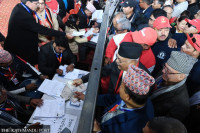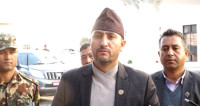National
Parties’ promises in doubt as most are drafting local poll manifestos centrally
Until local committees get to draw their bespoke manifestos, such papers become mere campaign rhetoric, experts say.
Binod Ghimire
During the 2017 local elections, Nepali political parties competed to make taller and taller promises to the public through their election manifestos.
The Nepali Congress said it would turn Nepal into a middle-income country in the next 10 years by achieving a steady annual economic growth of seven to ten percent. Adding 300,000 to 500,000 new jobs annually and mobilising national and international investments in the energy, tourism and agriculture sectors were other commitments of the party. It also promised to build flyovers, tunnel roads and overhead bridges, and operate monorails in big cities.
The manifesto of the CPN-UML wasn’t different either. It announced to generate 15,000 megawatts of electricity by completing the construction of the Karnali Chisapani Multipurpose Project, and Tamor, Nalsingad, Naumure and Budhigandaki hydropower projects. It also said the surplus energy would be sold in the international market. Upgrade of the Tribhuvan International Airport, construction of a modern international airport in Nijgadh, bringing reforms to the state-owned Nepal Airlines and adding flights to the countries where a large numbers of Nepali reside were other the other commitments the UML made in its election manifesto. It also announced to increase the old-age allowance to Rs5,000 per month.
The many promises the two large parties made for the local elections were beyond the jurisdictions of local governments. Local governments neither have resources nor the capability to make good on the promises.
The CPN (Maoist Centre) was no different. While the Constitution of Nepal clearly says it is the federal government that deals with issues related to national borders, the party’s manifesto for local elections promised to bring measures to stop Indian encroachment of the southern border. The party claimed local governments along the border areas would work to stop encroachments.
As the May 13 local elections draw closer, the parties’ central offices in Kathmandu have started unveiling their election manifestos. Along with the CPN (Unified Socialist), the Rastriya Prajatantra Party and the Rastriya Janamorcha have brought out their election manifestos for local elections. The UML and Congress are in final preparations to unveil them.
Except for the Maoist Centre, all other parties have prepared their manifestos at party headquarters and are unveiling them centrally.
Political experts say this one-size-fits-all approach of the parties is wrong because such manifestos cannot address issues and problems which vary from city to city and village to village.
“The manifestos can be prepared centrally for federal elections but this approach does not work for local elections,” Meena Vaidya Malla, a professor and former chief of the Political Science Department at the Tribhuvan University, told the Post. “The local committees of each political party should be involved in preparing the manifestos for local elections.”
The needs of mountain villages and those in the hills or the Tarai are entirely different from one another, and parties should not be mixing national issues and local ones, according to her.
For instance, in its manifesto for local elections, the Rastriya Janamorcha has said scrapping federalism is its major agenda. In reality, implementing the party’s agenda is beyond the jurisdiction of the local government.
Similarly, the CPN (Unified Socialist) has promised free electricity upto 200 units for households and announced that it would brand local alcohol. But both of these commitments cannot be fulfilled without federal support.
Experts say if the parties are really serious about addressing local problems then they should consult people from the respective local units to make their manifestos realistic.
“As the manifestos are prepared without proper study and consultations, most of them end up being mere campaign rhetoric,” Ram Krishna Tiwari, a professor of political science at the Tribhuvan University, told the Post.
According to political experts, the constitution has broadly categorised the responsibilities of the local level and if the manifestos are prepared based on them, they will be realistic.
The constitution has given 22 explicit powers to local governments which are directly linked to the day-to-day life of the public. From school education, basic health care services, local roads, irrigation projects, to the distribution of land and houses to squatters, local governments have a plethora of services to offer at people’s doorsteps.
“The nature of need of one local level is different from another. So, if they want to make their promises realistic then the parties should allow their local committees to prepare the manifestos.”




 15.12°C Kathmandu
15.12°C Kathmandu















